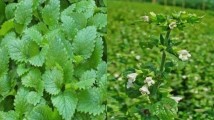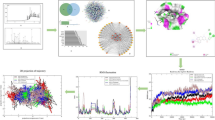Abstract
Turmeric, since in ancient Indian traditional medicinal system, has been implicated for its therapeutic and chemopreventive properties against a broad spectrum of diseases. Curcumin, the active polyphenol from turmeric, helps to obstruct the growth of many types of cancers at various stages which include prostrate, melanoma, breast, brain tumor, pancreatic, leukemia, etc. The initiation and recurrence of cancer have been attributed to few mutated cells in bulk of tumor called as cancer stem cells which have the capacity of self-renewal and differentiation. Glycogen synthase kinase-3 beta (GSK-3B) is a multifunctional serine/threonine protein kinase, originally found in mammals, an important component of diverse signaling pathways, dysregulation of which leads to affect the cancer stem cell properties. The nutritional- and phytochemical-based dietary interventions may complement current chemotherapy to prevent recurrence and relapse of cancer. The objective of present study is to investigate the effect of retinoic acid and curcumin–retinoic acid conjugates against GSK-3B protein. The in silico results indicate that molecule 3 (curcumin–retinoic acid conjugates) might be a potent inhibitor of GSK-3B and a novel future drug candidate for the treatment of cancer.




Similar content being viewed by others
References
Berman HM, Westbrook J, Feng Z, Gilliland G, Bhat TN, Weissig H, Shindyalov IN, Bourne PE (2000) The protein data bank. Nucleic Acids Res 28:235–242
Beurel E, Grieco SF, Jope RS (2015) Glycogen synthase kinase-3 (GSK3): regulation, actions, and diseases. Pharmacol Ther 148:114–131
Bharti AC, Donato N, Singh S, Aggarwal BB (2003) Curcumin (diferuloylmethane) down-regulates the constitutive activation of nuclear factor-kappa B and Ikappa B alpha kinase in human multiple myeloma cells, leading to suppression of proliferation and induction of apoptosis. Blood 101(3):1053–1062
CLC drug discovery work bench/Molegro Virtual Docker: CLC Inc A, Denmark. http://www.clcbio.com/products/clc-drug-discovery-workbench. Accessed 25 Jan 2016
Davies H, Glodzik D, Morganella S, Yates LR, Staaf J, Zou X et al (2017) HRDetect is a predictor of BRCA1 and BRCA2 deficiency based on mutational signatures. Nat Med 23(4):517
Doble BW, Woodgett JR (2003) GSK-3: tricks of the trade for a multi-tasking kinase. J Cell Sci 116(Pt 7):1175–1186
Gentile G, Merlo G, Pozzan A, Bernasconi G, Bax B, Bamborough P, Bridges A, Carter P, Neu M, Yao G, Brough C, Cutler G, Coffin A, Belyanskaya S (2012), 5-Aryl-4-carboxamide-1,3-oxazoles: potent and selective Gsk-3 inhibitors. Bioorg Med Chem Lett 22:1989
Grimes CA, Jope RS (2001) The multifaceted roles of glycogen synthase kinase 3beta in cellular signaling. Prog Neurobiol 65(4):391–426
Jauliac S, López-Rodriguez C, Shaw LM, Brown LF, Rao A, Toker A (2002) The role of NFAT transcription factors in integrin-mediated carcinoma invasion. Nat Cell Biol 4(7):540–544
Keservani RK, Kesharwani RK, Vyas N, Chadokar A (2010a) Nutritional supplements: an overview. Int J Curr Pharm Res 1(1):59–75
Keservani RK, Kesharwani RK, Vyas N, Jain S, Raghuvanshi R, Sharma AK (2010b) Nutraceutical and functional food as future food: a review. Der Pharm Lett 2(1):106–116
Kesharwani RK, Misra K (2011) Prediction of binding site for curcuminoids at human topoisomerase II α protein; an in silico approach. Curr Sci 101(8):1060–1064
Kesharwani RK, Srivastava V, Singh P, Rizvi SI, Adeppa K, Misra K (2015) A novel approach for overcoming drug resistance in breast cancer chemotherapy by targeting new synthetic curcumin analogues against aldehyde dehydrogenase 1 (ALDH1A1) and glycogen synthase kinase-3 β (GSK-3β). Appl Biochem Biotechnol. https://doi.org/10.1007/s12010-015-1696-x
Kesharwani RK, Singh DB, Singh DV, Misra K (2018) Computational study of curcumin analogues by targeting DNA topoisomerase II: a structure-based drug designing approach. Netw Model Anal Health Inform Bioinform 7:15. https://doi.org/10.1007/s13721-018-0179-8
Wallace AC, Laskowski RA, Thornton JM (1995) LIGPLOT: a program to generate schematic diagrams of protein-ligand interactions. Prot Eng 8:127–134
Luo J (2008) Glycogen synthase kinase 3β (GSK3β) in tumorigenesis and cancer chemotherapy. Cancer Lett 273(2):194–200
Martinez GJ, Pereira RM, Äijö T, Kim EY, Marangoni F, Pipkin ME et al (2015) The transcription factor NFAT promotes exhaustion of activated CD8 + T cells. Immunity 42(2):265–278
Nusse R (2005) Wnt signaling in disease and in development. Cell Res 15(1):28–33
Singh DB, Gupta MK, Kesharwani RK, Misra K (2013) Comparative docking and ADMET study of some curcumin derivatives and herbal congeners targeting b-amyloid. Netw Model Anal Health Inform Bioinform 2:13–27. https://doi.org/10.1007/s13721-012-0021-7
Singh DV, Agarwal S, Kesharwani RK, Misra K (2014) 3D QSAR and pharmacophore study of curcuminoids and curcumin analogs: interaction with thioredoxin reductase. Interdiscip Sci 5(4):286–295
Upadhyaya J, Kesharwani RK, Misra K (2009) Metabolism, pharmacokinetics and bioavailability of ascorbic acid; synergistic effect with tocopherols and curcumin. J Comput Intell Bioinform 2(1):77–84
Acknowledgements
One of the authors, Rajesh K. Kesharwani, is thankful to Prof. Krishna Misra, Honorary Professor, Indian Institute of Information Technology, Allahabad, for her kind suggestion for completion of the work.
Author information
Authors and Affiliations
Corresponding authors
Ethics declarations
Conflict of interest
The authors report no conflict of interest.
Rights and permissions
About this article
Cite this article
Mishra, H., Kesharwani, R.K., Singh, D.B. et al. Computational simulation of inhibitory effects of curcumin, retinoic acid and their conjugates on GSK-3 beta. Netw Model Anal Health Inform Bioinforma 8, 3 (2019). https://doi.org/10.1007/s13721-018-0177-x
Received:
Accepted:
Published:
DOI: https://doi.org/10.1007/s13721-018-0177-x




